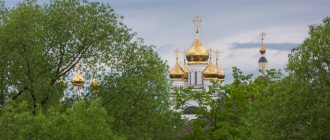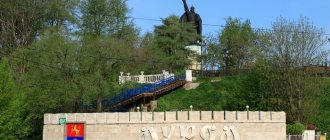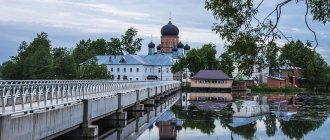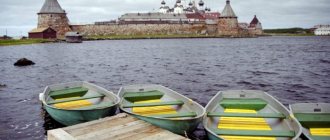What temples can you see in Simferopol?
Unique shrines of Crimea can be found in Simferopol. The city is not only an important transport hub, but also has valuable attractions. At the beginning of the 20th century, the Alexander Nevsky Cathedral was considered the main cathedral of the city. The church was then destroyed and is currently being restored. This historical monument is located in the city center near Victory Square.
The idea of erecting this structure belonged to Catherine II. More than 30 icons were created in the icon painting workshop in St. Petersburg. The cathedral housed valuable relics presented by the empress: a Gospel, a censer, a water ladle and a tabernacle. In 1999, a decision was made to rebuild the cathedral.
At the end of the 19th century, Maxim Gorky worked on the repair work of the temple. The great composer Sasha Spendiarov sang in the cathedral choir.
Interesting facts about the peninsula
The following attractions are worth visiting in Simferopol:
- Peter and Paul Cathedral, which was erected in the 19th century at the expense of city residents. In 2004, a miracle happened in the temple, on the glass behind which stood an icon of St. Nicholas the Wonderworker - his face appeared. The appearance of the church combines different stylistic trends: ancient Russian architecture, classical elements. There is a bell tower above the entrance, and a stone staircase leads to the porch. The cathedral is located on Oktyabrskaya Street;
- On Odesskaya Street you can find the Holy Trinity Convent. It was erected back in the 18th century. The interior decoration of the church looks great: the image of the Lord is painted in the dome, and the four Evangelists are painted on individual elements. The relics of St. Luke are kept in the temple. And also one of the famous shrines of Crimea - the renewed icon of the Mother of God;
- The temple complex of the Three Saints can be visited on Gogol Street. The building was built according to the design of Eremeev and Grachev in the style of Russian classicism. The temple is decorated with elegant elements of ancient Russian architecture: small turrets, multi-stage cornices and decorative kokoshniks in the window openings. In the center of the room there is an image of saints, painted by the artist Pravednikov.
The Church of the Three Saints is decorated with a cross about six meters high. It was installed using a helicopter.
Blagoveshchensky cathedral
At the end of the twentieth century, monks began to inhabit the Southern Monastery Complex again. Now the Annunciation Cathedral operates here. Here, as many centuries ago, services are held. This place is very revered by believers, and many pilgrims come here every year.
By the way, here is the miraculous icon of Our Lady of the Quick to Hear, which helps fight various diseases. So those who want to visit the holy places of Crimea that heal people can come here.
One of the most revered places by believers is the monastery of St. Anastasia the Pattern Maker. It is especially famous because there was a healing spring here. They say that even many Crimean Tatars who were healed in this place converted to the Christian faith.
Unique monasteries of Feodosia!
Considering the ancient sights of Crimea, it is worth highlighting the Church of John the Baptist. It is located on Starokarantinnaya Street. Its construction dates back to the 13th-14th centuries. The temple is a square structure, which is decorated with an octagonal element with a dome and windows in the form of loopholes. During Soviet times, the church was closed and was considered an architectural reserve. In the 90s, restoration of the building began. After the completion of the renovation work, the temple was illuminated and handed over to the Orthodox Church.
The following Orthodox monasteries of Feodosia are worth visiting:
- The Vvedensky Church is located on Krasnoarmeyskaya Street. It belongs to the oldest temples in the city. It was founded in the 7th-9th centuries. In the 90s of the last century, the building was restored;
- During the 20th century, the Cathedral of the Icon of the Kazan Mother of God was erected. It was made in the traditions of the Russian-Byzantine style.
The temple seems light thanks to the semicircular elements and graceful columns on the sides of the building. The entrance is decorated with three connected arches.
The Temple of the Kazan Mother of God is located on Karl Marx Street.
What is worth visiting in Alushta?
On the territory of Alushta there are interesting Orthodox shrines of Crimea. High in the mountains you can find the Kosmo-Damianovsky Monastery. This is a monastery, which is located within the natural reserve of Crimea. It was rebuilt at the end of the 19th century near the healing spring of Damian and Kosma. On Orthodox holidays, more than six thousand pilgrims come to the holy place.
The only day when anyone can visit the monastery is July 14th. Access by car to the reserve is limited. From Alushta, on the road to the village of Izobilnoye, after the turn there is a pocket. If you go up the steps, you can get to the reserve building, where you can purchase a special permit to enter the territory of the reserve zone.
In the village of Malorechenskoye there is a lighthouse temple of St. Nicholas the Wonderworker. You can get to it by bus, which goes to the village of Rybachye. The temple was erected in memory of those who died on the water. It was built with the blessing of Patriarch Alexei II.
The temple is distinguished by the following features:
- This Crimean temple has the highest height among similar buildings;
- When decorating, anchor chains and an unusual bell tower with electric bells were used;
- The architectural elements are created in the Greek style;
- Under the main cross there is a lighthouse lantern;
- The iconostasis would be made of valuable wood and decorated with gilding;
- The murals depict the life story of Nicholas of Myra, who is the patron saint of travelers and sailors;
- The temple was erected at the expense of the famous politician Alexander Lebedev.
In the basement of the church there is a disaster museum.
A catastrophe larger than the Titanic occurred near Gurzuf; the ship Armenia was attacked by fascist aircraft on November 7, 1941. In this case, 7 thousand people died. (On the Titanic 1.5 thousand).
Source of St. Panteleimon
Once upon a time, a bloody battle took place on the plateau between the Scythians and the Huns. According to another legend, pagans gathered at the holy place. The Orthodox history of the spring began thanks to the Greek Mary, who was healed of psoriasis by its water. Later, Prince Potemkin, Pototskaya, and representatives of the imperial dynasty visited the shrine. Miracles at the source still occur today.
To touch the shrine, you need to come by public or your own transport to the city of Stary Krym. Then we move to the southern outskirts to the end of the residential sector, until a view of the gully of the Churuk-Su River opens. A little further from it the Chapel of Panteleimon will be visible.
And there are dozens more such places of worship in Crimea. This is Chersonesus, and the Church of Elijah the Prophet, and the Holy Intercession Convent... A visit to them is truly blessed.
Amazing monasteries of Yalta!
Numerous holy sights are located in Yalta. The young churches include the Holy Assumption Cathedral in Gurzuf. It can be found near the Kiparisny camp. It was built at the expense of the famous Russian industrialist Gubonin, who came from a peasant background. A ceremonial laying took place on the embankment. The temple was dismantled. Parishioners raised funds to restore the church. In 2004, a new cathedral was rebuilt.
In Yalta you can see the following Orthodox buildings of Crimea:
- Next to the Nikitsky Botanical Garden is the Church of the Transfiguration of the Lord. It was built in the Byzantine style with elements of Russian temple culture;
You can get to the temple complex by minibuses from Yalta or by trolleybus.
- On Polikurovsky Hill in the center of old Yalta you can find the Church of St. John Chrysostom. It was built according to the design of the architect Torricelli. It is located on Tolstoy Street;
- The most important Orthodox church in the city is the Alexander Nevsky Cathedral. It was created in the Old Russian style with tent elements. The decoration inside is made in Byzantine style. The walls are decorated with continuous painting. The temple complex can be found on Sadovaya Street;
- At the Livadia Palace you can see the Church of the Exaltation of the Cross. It was founded in 1862 and built according to the drawings of the architect Monighetti. The building is made in the Byzantine style;
The last Emperor of Russia, Nicholas II, took the oath of office in the Holy Cross Church.
- In Gaspra there is the Church of St. Nina. It was made according to Krasnov's design. The building was built at the beginning of the 20th century. Currently, the temple has been restored. It is located next to the Dnepr sanatorium;
- In Alupka you can find the Church of St. Archangel Michael. This Orthodox church was erected in the 18th century at the expense of Count Vorontsov and according to the design of the architect Elson. The building is made in the Russian-Byzantine style;
You can get to the temple from the bus station in Yalta to the station in Alupka.
- On the steep cliff of the Red Rock in Foros there is the Church of the Resurrection of Christ. It is an architectural monument of the 19th century. The church is decorated with floral ornaments and stained glass windows.
City of Doros (Theodoro)
The mountain called Mangup is also unusually rich in historical and religious monuments. The most ancient archaeological finds date back to the Eneolithic era. As early as the third century AD, settlements were located here, already fortified. Then the population just arrived. In the fifth century, during the reign of Justinian I, a fortress was erected here and the city of Doros was founded. In the vicinity was the country of Dori. In the tenth century the city fell into decline. Scientists attribute this to the earthquake that occurred during that period. Then the country around and the city itself were called Theodoro.
Also interesting here is the cave monastery complex. It looks like a grotto, with cells and a temple on different sides. There, on Cape Teshkli-Burun, is the Citadel of the Mungup princes, and behind it the octagonal temple. Later the Turks turned it into a mosque. There are also the Church of St. George and the Cathedral of St. Constantine nearby. Scientists suggest that they existed until the seventeenth century. The Ottomans rebuilt and renamed the city. Until the end of the eighteenth century, a Karaite community lived here. Regardless of who occupies the caves located on the territory of the peninsula, one thing can undoubtedly be said: these are the holy places of Crimea.
What shrines are worth seeing in Sevastopol?
Interesting sights can be found in the vicinity of Sevastopol. In the village of Flotskoye there is a medieval temple of Constantine and Helena. The building is a basilica with one nave and a decorated portico. You can get to the temple by bus from Balaklava or Sevastopol.
Booking.com
It is recommended to visit the following temple complexes in Crimea:
- In the 18th century, the temple of the twelve apostles was erected. Restoration work was carried out according to Lositsky's drawings. The relics of Blessed Basil and St. Sergius of Radonezh are kept in the temple. The building is located on Kuprin Street;
- On the rock of the Holy Apparition of Cape Fiolent is the Balaklava St. George Monastery. Many famous people are buried in its necropolis;
- On the territory of the Vladimir Cathedral there is a tomb of the admirals of the Russian fleet. The cathedral contains rare icons of the Mother of God, the Inexhaustible Chalice and the Sovereign. You can get to the cathedral via Sinopsky Descent.
Ancient temples and cave monasteries of Crimea attract pilgrims from all over the world. The Crimean peninsula preserves Christian shrines from different eras.
Relics of Luka Krymsky
In the Holy Trinity Cathedral, in a silver shrine, donated in 2001 by Greek priests, rest the relics of St. Luke of Crimea (in the world of Voino-Yasenetsky). This amazing man, a surgeon by profession, an archbishop who served in the cathedral from 1946 to 1961, experienced many troubles, was persecuted and despised. He lost his wife early and was sent into exile beyond the Arctic Circle. But he retained Christian charity and saved many people from death on the surgical table.
There is a museum of St. Luke on the monastery territory. Pilgrims from all over the country come to the relics to ask for help from the saint. And there are many known cases of healing of parishioners. Every Friday during the prayer service one is allowed to venerate the relics.











